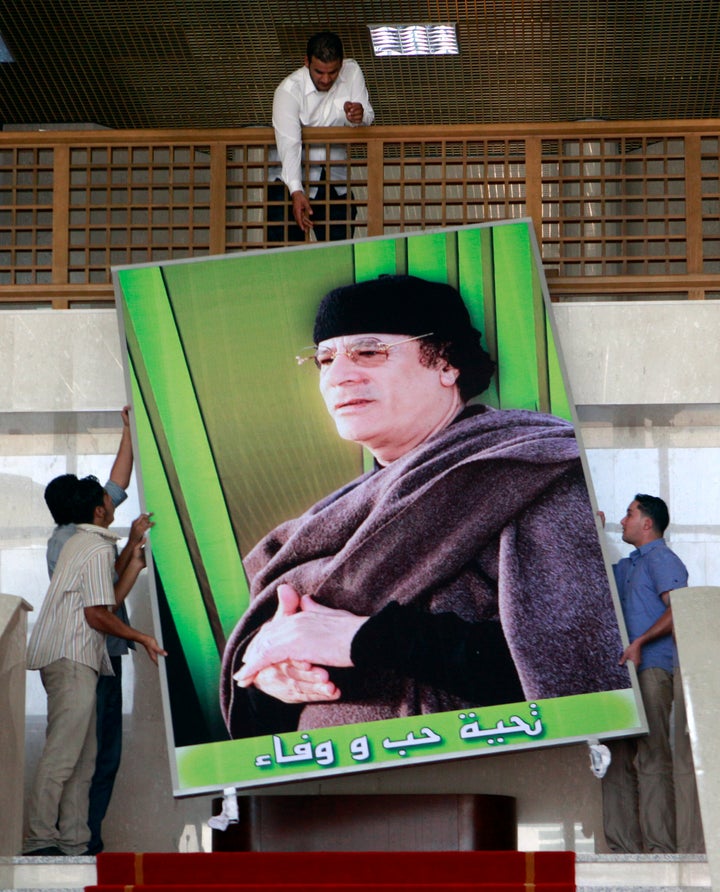
Earlier this week, rebel forces in Libya fought their way to the outskirts of Sirte, a seafront city about the size of Tallahassee. The day before, pushing westward along the coast from Ajdabiya, they'd recaptured the oil towns of Brega and Ras Lanuf -- Sirte, experts said, was the last major obstacle standing in the rebels' path to the capital city of Tripoli.
Sirte. Before Sunday, few outside Libya had heard of it. Now it's being portrayed as the key to Libya's hopes for democracy, the fulcrum on which the nation's fate would turn. Its importance can be explained partly by location, its proximity to the capital. But it mattered for other reasons, too, reasons that reveal a lot about a conflict with complexities outsiders are only beginning to grasp.
In 1942, as every Libyan schoolchild knows, a future authoritarian ruler was born in a tent outside the city. He went to school in the city itself, not that it was much of a city at the time. Even after he came to power in 1969, Sirte was a quiet rural outpost in a country that was pretty provincial.
Then, in the late 1980s, he decided to make his hometown the new capital. So what if it was in the middle of nowhere? He was Muammar al-Gaddafi. Who would stop him?
He began moving government offices there and ordered the construction of Soviet-style administrative buildings. He built a conference center whose unusual design brings to mind an enormous tent. Sirte would be his Brasilia, a fabricated city in the wilderness. It was a monument to an idea, that idea being the greatness of Gaddafi.
The plan never panned out. Even with its new hotels and wide, well-paved roads, Sirte was a dull backwater and no one wanted to move there, certainly not government officials who made lives for themselves in Tripoli. In a rare instance of Gaddafi not getting what he wanted, the officials stayed where they were. But the hotels, the conference centers, the infrastructure -- all remained intact.
Charles O. Cecil, a retired diplomat who served in Libya in 2006, said that during his stay in the country many of these buildings stood half-empty, concrete-and-glass metaphors for the unfulfilled promises of Gaddafi's so-called revolution. A city built as a monument to Gaddafi's power had turned out to be, quite literally, an empty symbol.
Well, almost empty. Sirte still carries symbolic weight. Even though it never became the bustling capital that Gaddafi may have imagined, Gaddafi did succeed in turning it into a sort of city-shaped vanity mirror.
In the two decades or so since he built it up, Gaddafi has entertained a cavalcade of foreign leaders there, and it was in Sirte that the document calling for the founding of the African Union was signed in 1999. About 10 years ago, when Gaddafi began talking about creating a United States of Africa, he named Sirte the capital. (The unspoken implication was that the first president of Africa would be -- who else? -- Col. Gaddafi.)
Symbolism aside, there's also a more practical reason why Sirte represents an anchor for Gaddafi's hold on the country. About half the population of Sirte belongs to Gaddafi's tribe, the Gadhadhfa, and the area surrounding the city is often described as Gaddafi's stronghold. Just how strong Gaddafi's hold is is unclear -- the answer varies depending who you ask.
But there's certainly reason to expect that if the rebels do capture the city, they won't find it covered with anti-Gaddafi graffiti like cities to the east; they'll find enemies, and not just Gaddafi's soldiers.
Gaddafi's investments in Sirte have amounted to a huge windfall for the Gadhadhfa and their allies. By building a city where there was little more than a village, he created "new opportunities for patronage," as Cecil, the retired diplomat, said: "More janitors, more clerks, more taxi drivers."
According to Ronald Bruce St John, the author of several books on Libya, this was all part of a deliberate strategy to ensure that he stayed in power and stayed alive. "He has long felt threatened by forces inside and outside Libya and he turned, early on, to his own tribe, his blood relatives, as the most likely people to protect him," St John said.
If Sirte falls to the rebels, what happens next will say a lot about the extent to which the current conflict comes down to a question of tribe. So far, much of the coverage of the battle has portrayed it as a fight between freedom-seeking rebels and a dictator's army, but some observers have argued that the conflict is more tribal war than revolution.
One of the loudest proponents of this view is Benjamin Barber, president of the New York-based think tank CivWorld. Barber, who worked as an adviser to Gaddafi's son Saif on what he describes as democratic reforms -- and who has written blogs for The Huffington Post -- likened Libya's social structure to that of "Sicily and the Mafia."
"If Gaddafi can't hold Sirte as a loyalist clan, then the clan loyalties are fraying in ways that bode ill for his destiny," Barber said.
But Barber believes that those loyalties haven't frayed, and that the people of Sirte will stand up for their tribesman and patron. If so, the rebels won't take Sirte -- not without killing civilians loyal to Gaddafi.
And if they start killing civilians, that changes everything. Libya may end up looking less like Tunisia or Egypt than Somalia, or Iraq.